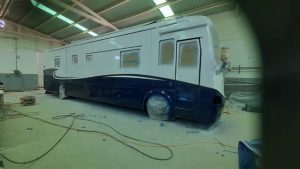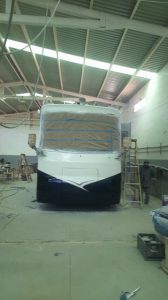Since deciding I was bringing my coach to Mexico, I had been researching tracking devices to install on the coach. In the end I had three. Redundancy is a good thing! Something to look for is one that either uses satellite or cellular to update the map. If cellular, make sure it’s 4G, as 3G is being turned off. AT&T’s 3G went away just this last February.
![]() The first one was a Linxup Asset Tracker. It only uses VHB tape to stick it to the roof and has a small solar panel that keeps the battery charged. I had worked with the vendor for a few weeks after getting it to make sure it was working as intended. I drove it around San Diego while checking the tracking and found it was updating every 20 minutes instead of every 10 minutes as it was supposed to do. It took a few phone calls to figure out what was happening.
The first one was a Linxup Asset Tracker. It only uses VHB tape to stick it to the roof and has a small solar panel that keeps the battery charged. I had worked with the vendor for a few weeks after getting it to make sure it was working as intended. I drove it around San Diego while checking the tracking and found it was updating every 20 minutes instead of every 10 minutes as it was supposed to do. It took a few phone calls to figure out what was happening.
Turns out on their new builds, they changed that to every 20 minutes so long-haul truckers (driving 24 hours a day) didn’t kill the batteries in the winters. Once we figured that out, they reversed the firmware in my tracker to update every 10 minutes while moving. (It updates every 3 hours when stationary.) Linxup Solar Asset Tracker After I saw it working, I glued it down to the roof of our Bus.
Second tracker was just adding a $32 GPS antenna to my existing Cerbo GX device and that was as easy as plugging it in; but that required having a way to update the VRM website, meaning I had to leave my cellular router in and active in the coach. GPS antenna I added to Cerbo GX. I placed this inside the coach as close to the ceiling as I could. It works perfectly. I was not sure it would work without being on the roof, but it does!
 The third tracker was an impulse buy of an Apple Air Tag. I wasn’t sure it would work, but it worked so well I have since bought 4 more and added one to each of our vehicles in case they ever get stolen. They are cheap, $29, and no
The third tracker was an impulse buy of an Apple Air Tag. I wasn’t sure it would work, but it worked so well I have since bought 4 more and added one to each of our vehicles in case they ever get stolen. They are cheap, $29, and no  monthly fee like the Asset Tracker. Apple AirTag
monthly fee like the Asset Tracker. Apple AirTag
Antonio, my painter, provided a 50-amp outlet to plug my motorhome into inside the building, so I did because my solar panels weren’t going to help keep the batteries charged while inside that  building. That allowed me to keep the inverter on and the 120v cameras turned on. (Note to self: in hindsight, putting a camera on the wall pointing at the coach would have been a great way to see what was happening while I was back home, but I didn’t think of that until I was almost to
building. That allowed me to keep the inverter on and the 120v cameras turned on. (Note to self: in hindsight, putting a camera on the wall pointing at the coach would have been a great way to see what was happening while I was back home, but I didn’t think of that until I was almost to  the house when driving back. Next time — err, I hope there isn’t a next time!) They also had WiFi available, pretty slow, but it worked.
the house when driving back. Next time — err, I hope there isn’t a next time!) They also had WiFi available, pretty slow, but it worked. 
My Cerbo GX allowed me to monitor the RV’s power and batteries while it was down there. The solar asset tracker  had no sun for charging for about 5 weeks. It was down to about 49% battery remaining when the bus got moved into the sun to allow the clear coat to cure. The folks at Linxup didn’t think the battery could last that long without charging, but thankfully they were incorrect!
had no sun for charging for about 5 weeks. It was down to about 49% battery remaining when the bus got moved into the sun to allow the clear coat to cure. The folks at Linxup didn’t think the battery could last that long without charging, but thankfully they were incorrect!
The Cerbo GX allowed me to keep track of the batteries while I was away from the bus. I have it set up to send all the solar/battery & temperature information to their free VRM web dashboard available to me from any device or web browser (and now it had GPS built in).
 A few weeks into the job, the Cerbo battery information stopped updating the website, but the cameras were still available to view and hear. Still, I am not sure exactly why that happened. The Cerbo stopped
A few weeks into the job, the Cerbo battery information stopped updating the website, but the cameras were still available to view and hear. Still, I am not sure exactly why that happened. The Cerbo stopped  sending data on 2/23 @ 6pm and started sending it again on 3/10 @10am when it was being moved outside for the clear coat to cure in the sun. So for two weeks I was in the dark about the battery’s condition. I also did not know it had lost shore power. I will be installing a new Hughes hardwired Power Watchdog this summer to enable tracking our shore power.
sending data on 2/23 @ 6pm and started sending it again on 3/10 @10am when it was being moved outside for the clear coat to cure in the sun. So for two weeks I was in the dark about the battery’s condition. I also did not know it had lost shore power. I will be installing a new Hughes hardwired Power Watchdog this summer to enable tracking our shore power.
The Wyze Cams I have installed in the bus allowed me to see things inside the coach and, most importantly, allowed me to hear what was going on. Since all the window openings and windshield were papered over, the cameras weren’t very useful for video at that time. A few times a week I  connected to one of the cameras and listened to what was going on. It seemed to me someone was sanding the bus for three weeks, 6 days a week. I started to wonder if there would be any fiberglass left when they finished. 🙂
connected to one of the cameras and listened to what was going on. It seemed to me someone was sanding the bus for three weeks, 6 days a week. I started to wonder if there would be any fiberglass left when they finished. 🙂
Along the way I would message Antonio to send pics and he would send some that night. 
The morning the bus was moved, I got a lot of alerts that something was happening and I went to the cameras to see what was going on. Antonio was driving the bus from the paint building to his home and I could see him going down the road, so I knew what was going  on. Later that evening I called him to turn on the solar controllers allowing the batteries to charge again. (I had turned them off as they consume about 25 watts and due to being inside did not provide any power to offset that draw.) It took a bit to communicate that to Antonio’s tio so that Antonio could turn them on in the correct order.
on. Later that evening I called him to turn on the solar controllers allowing the batteries to charge again. (I had turned them off as they consume about 25 watts and due to being inside did not provide any power to offset that draw.) It took a bit to communicate that to Antonio’s tio so that Antonio could turn them on in the correct order.
Once the bus cured in the sun for about a week, they started the process of polishing the paint. It looked good in the pics when unpolished; but once a section was polished, it look amazing! (I had no idea what a difference that would make.) 
I communicated with Antonio mostly via FB Messenger to get an approximate date I should come down. I picked a day as we got closer so I could be around when all the “stuff” was getting reinstalled on the exterior, including the windows.
I will finish this up in another post.







